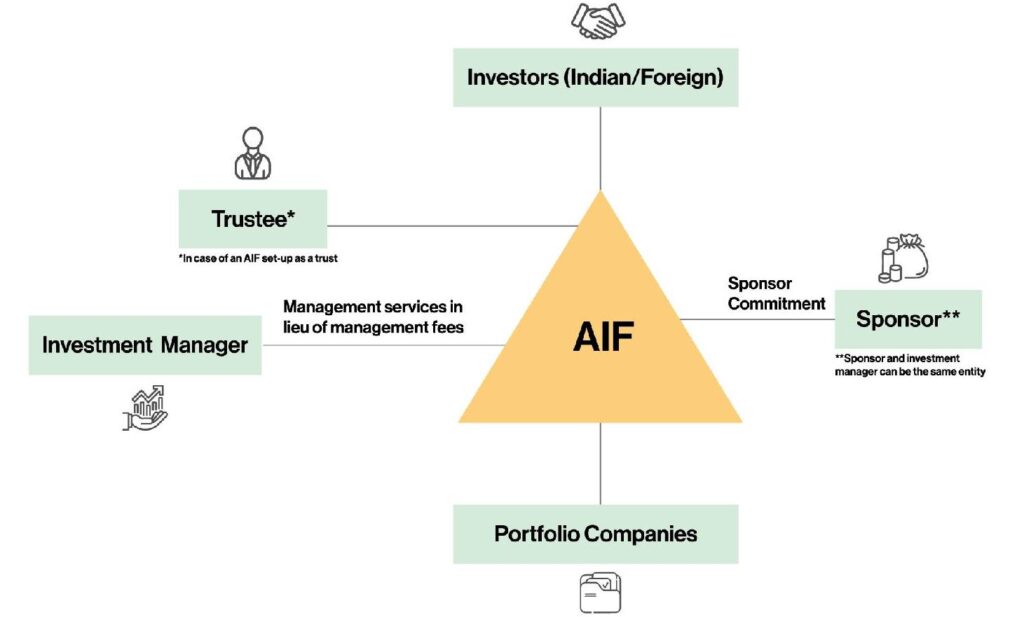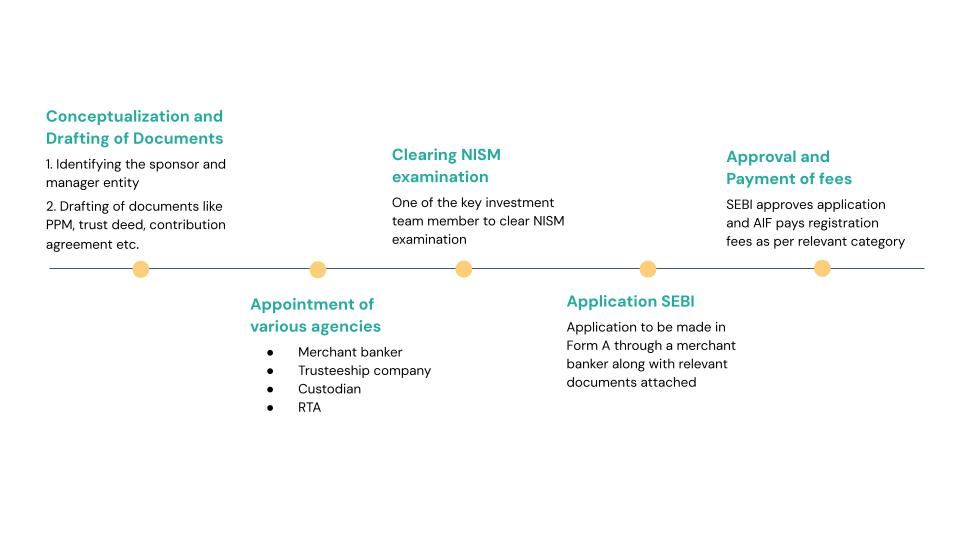Quick Summary
An Alternative Investment Fund (AIF) is a privately pooled investment vehicle that gathers funds from investors, whether Indian or foreign, for investment as per a defined investment policy to benefit its investors. Explicitly regulated by the Securities and Exchange Board of India (SEBI) under the SEBI (Alternative Investment Funds) Regulations, 2012, AIFs can be established in India as a trust, company, Limited Liability Partnership (LLP), or a body corporate. AIFs are categorized into three types:
- Category I AIFs: These funds invest in sectors considered socially or economically desirable, such as venture capital, infrastructure, and small and medium enterprises (SMEs).
- Category II AIFs: This category includes private equity funds and debt funds that do not receive specific incentives or concessions.
- Category III AIFs: Funds employing diverse or complex trading strategies, including hedge funds, fall under this category.
Investing in AIFs offers potential for high returns across various asset classes, making them an attractive option for high-net-worth individuals seeking portfolio diversification. However, it’s crucial to understand the regulatory framework and inherent risks associated with these investments.
Blog Content Overview
- 1 Overview
- 2 What are Alternative Investment Funds (AIFs)?
- 3 Regulatory Framework for AIFs
- 4 Key Characteristics of Alternative Investment Funds (AIFs)
- 5 Key Investment Team
- 6 Taxation of Alternative Investment Funds (AIFs)
- 7 Key Documents
- 8 Tenure and Listing of Alternative Investment Funds / Schemes
- 9 How to get registered with SEBI?
- 10 Final Thoughts
- 11 Annexure 1 – Details of NISM Examination
- 12 Need Expert Guidance in Setting up AIF?
Overview
Alternative Investment Funds in India, often abbreviated as AIFs, have become a buzzword among sophisticated investors, especially High Net Worth Individuals (HNIs). HNIs hold a growing share of the global wealth, with 48% of global wealth controlled by HNIs in 2023, expected to rise to 55% in the near future. HNI AUM (Assets Under Management) invested in AIFs is expected to increase, with HNIs’ AIF allocation expected to double to 25% over the next decade.
As of May 2025, there are 1,550 registered AIFs in India1. This domain has witnessed remarkable growth, underscored by an almost 110% surge in commitments which escalated to Rs. 13.49 trillion in the fiscal year 2024-25 from Rs. 6.41 trillion in 2021-222. This growth translated to a substantial Rs. 7.07 trillion jump within three years. AIFs have shown superior IRRs (Internal Rate of Returns) compared to traditional Asset Management Companies (AMCs). This higher performance has led to a higher valuation premium for AIFs over traditional AMCs.
The total assets under management (AUM) of AIFs have grown at a CAGR (Compound Annual Growth Rate) of 28% between June FY19 and June FY24s3. 75% of AIFs have successfully generated positive alpha, compared to a lower alpha generation in equity AMCs, where 51% of large-cap funds and 26% of mid-cap funds were unable to deliver alpha over the past year4.
Equity AIFs have outperformed the BSE Sensex TRI index PME+ for five consecutive years. 80% of registered AIFs fall under Category I & II (venture capital, private equity, debt funds). ~₹4.4Tn invested, with ~70% allocated to unlisted securities. 44% of new schemes (2022–2024) were launched by first-time fund managers, highlighting strong market confidence5.
The breakdown of the alternatives market is dominated by Private Equity (PE) and Real Assets, which are USD 250 billion and USD 125 billion, respectively. Private Credit, a growing segment, stands at USD 25 billion in the Indian market. AIFs are projected to represent 15% of the total AUM in India’s wealth management industry by 2027.
In light of the burgeoning AIF industry, its regulatory authority, the Securities and Exchange Board of India (SEBI), hasn’t remained a silent observer. SEBI has proactively been fortifying protocols to guarantee investor safety, heighten transparency, and ensure fair practices within the AIF guidelines.
So, the question arises, what exactly are AIFs? And how do they function within the Indian regulatory landscape?
What are Alternative Investment Funds (AIFs)?
An Alternative Investment Fund (AIF) is a privately pooled investment vehicle that gathers funds from investors, whether Indian or foreign, for investment as per a defined investment policy to benefit its investors. Explicitly regulated by the Securities and Exchange Board of India (SEBI) under the SEBI (Alternative Investment Funds) Regulations, 2012, AIFs can be established in India as a trust, company, Limited Liability Partnership (LLP), or a body corporate.
AIFs are becoming a favoured choice for discerning investors, including High Net Worth Individuals (HNIs). With their promise of high returns across diverse asset classes, AIFs are attractive for those aiming to diversify and enhance their portfolios.
Some key terms used in AIFs
- Carry
Carry or carried interest in AIF is akin to performance fees which is paid to the investment manager as a share of the AIF’s profits which the investment manager is entitled to if they exceed a specific threshold return. Carry is typically in the range of 15-20% of the profits earned by the AIF in excess of the specified threshold. - Hurdle / Preferred rate of return
Minimum percentage of returns that an investor earns before the Investment Manager can catch-up and charge carry to investor. - Catch-up
Catch-up allows the investment manager to earn the hurdle rate of return on its investment in the AIF but only after the investors have received their investment along with the hurdle rate of return on such investment. - Distribution waterfall
Provides for an order of specified priority in which the distributions are made by AIF which includes the capital contributions, fees, hurdle, catch up (if any), carry, etc. - Closing
Closing is the date fixed by the Investment Manager as a cut-off date to obtain capital commitment from investors.
Regulatory Framework for AIFs
In India, AIFs operate under the purview of the Securities and Exchange Board of India (SEBI).
Since their establishment in the late 1980s, Venture Capital Funds (VCFs) have been a significant focus for the government to bolster the growth of specific sectors and early-stage companies. However, the desired outcomes in supporting emerging sectors and startups were not realized, largely due to regulatory uncertainties. Recognizing this challenge, in 2012, the Securities and Exchange Board of India unveiled the SEBI (Alternative Investment Funds) Regulations. This was done to categorize AIFs as a unique asset class, similar to Private Equities (PEs) and VCFs.
Any entity wishing to function as an AIF must seek registration with SEBI. While there are various legal structures under which an AIF can be established – such as a trust, a company, an LLP, or a body corporate – trusts are the most commonly chosen form in India.
A typical AIF structure looks like the following –


The entities are:
- Settlor – Person who settles the trust with a nominal initial settlement
- Trustee – Person in charge of the overall administration and management of the Trust. In practice, this responsibility is then outsourced to the investment manager.
- Contributor – Investor to the Trust (AIF) and makes a capital commitment to the AIF
- Sponsor – Face of the AIF i.e. Person who sets up the AIF
- Investment Manager – Brain of the AIF i.e. Person who is appointed to manage the investments
- Custodian – Safeguards the securities and assets of the AIF and facilitates settlement of transactions.
- Merchant Banker – Assists with due diligence certification for PPM.
- Registrar and Transfer Agent (RTA) – Maintains investor records, processes capital calls and distributions, and handles investor communications and reporting.
It’s noteworthy that the roles of the Sponsor and Investment Manager can be unified, with one entity performing both functions.
Categories of AIF
Under the SEBI AIF Regulations, AIFs are classified into 3 distinct categories or types. Each category serves a unique purpose and is characterized by specific investment conditions and varying degrees of regulatory oversight. Below is an overview of the categories, highlighting their primary purpose and key conditions:
| Parameters | Category I AIF | Category II AIF | Category III AIF |
| Definitions | Funds with strategies to invest in start-up or early stage ventures or social ventures or SMEs or infrastructure or other sectors or areas which the government or regulators consider as socially or economically desirable. Includes: Venture Capital Funds (angel funds are a sub-category of VCFs)SME fundsSocial Impact FundsInfrastructure FundsSpecial Situation Funds | Funds that cannot be categorized as Category I AIFs or Category III AIFs. These funds do not undertake leverage or borrowing other than to meet day-to-day operational requirements and as permitted in the AIF Regulations. Examples – Private Equity or Debt Funds | Funds which employ diverse or complex trading strategies and may employ leverage including through investment in listed or unlisted derivatives. Examples – Hedge funds or funds which trade with a view to make short-term returns |
| AIF Minimum ticket size | INR 1 crore | INR 1 crore | INR 1 crore |
| AIF Minimum fund size | INR 20 crore | INR 20 crore | INR 20 crore |
| Open or close ended AIF | Close-ended fund | Close-ended fund | Can be open or close-ended fund |
| Tenure | Minimum tenure of 3 years | Minimum tenure of 3 years | NA |
| Continuing interest of Sponsor / Manager (a.k.a skin in the game) | Lower of:2.5 % of corpusINR 5 crores | Lower of:2.5 % of corpusINR 5 crores | Lower of:5 % of corpusINR 10 crore |
| Investment outside India | Permissible subject to SEBI approval | Permissible subject to SEBI approval | Permissible subject to SEBI approval |
| Concentration norms | Cant invest more than 25% in 1 investee company | Cant invest more than 25% in 1 investee company | Cant invest more than 10% in 1 investee company |
| Borrowing | To not borrow funds except for : (a) temporary funds not more than 30 days (b) less than 4 occasions in a year Borrowing shall be limited to the lower of:i) 10% of investable fundsii) 20% of the proposed investment in the investee companyiii) undrawn commitment from investors other than the defaulting investors | (Same as Category 1 AIF) | Can engage in leverage & borrowing as per prescribed rules |
| Overall restrictions / compliances | Low | Medium | High |
| SEBI registration fees | INR 500,000 | INR 1,000,000 | INR 1,500,000 |
| Per scheme filing fees | INR 100,000 | INR 100,000 | INR 100,000 |
Table 1: Categories of AIFs
Apart from the categories mentioned above, any of the three categories of AIFs can be classified as a large-value fund (LVFs), provided that each investor is an “accredited investor” as per the AIF Regulations and invests a minimum of INR 70 crores in the AIF. LVFs have certain investment and compliance related exemptions.
Angel Funds also hold a distinct categorization under the AIF Regulations. These funds are a sub-category of Category I AIFs – VCFs, primarily designed to acknowledge and support the unique role of angel investors in the startup ecosystem. The key characteristics of Angel funds are summarised below:
| Parameters | Category I AIF |
|---|---|
| AIF Minimum ticket size | INR 25 lakhs |
| AIF Minimum fund size | INR 5 crore |
| Investments | Should be not less than INR 25 lakhs and not more than INR 10 crores, with a minimum lock-in period of 3 years. |
| Open or close ended AIF | Close-ended fund |
| Continuing interest of Sponsor / Manager(a.k.a skin in the game) | Lower of:2.5 % of corpusINR 50 lakhs |
| Investors | Angel investors who meet the specified criteria |
| SEBI registration fees | INR 200,000 |
| Per scheme filing fees | NIL |
Table 2: Angel Funds
Category I AIFs: Nurturing Growth and Social Impact
Category I AIFs are those funds that invest in start-up or early-stage ventures, special situation funds, social ventures, Small and Medium Enterprises (SMEs), infrastructure, or other sectors which the government or regulators consider as socially or economically desirable. These funds often receive incentives or concessions from the government due to their developmental role.
- Venture Capital Funds (VCFs): VCFs primarily focus on providing capital to early-stage, high-growth potential companies that are typically unlisted. They play a crucial role in fostering innovation and entrepreneurship. VCFs invest in businesses with scalable models, aiming for significant capital appreciation as these companies mature and potentially go public or get acquired. Their investments are often long-term and carry higher risk but also higher return potential.
- Angel Funds: A sub-category of Venture Capital Funds, Angel Funds specifically target seed-stage and early-stage startups. They pool money from angel investors (individuals or entities) to invest in budding businesses. A key characteristic is the minimum investment of ₹25 lakh (Rupees Twenty-Five Lakh) for each angel investor in such a fund. Angel Funds often provide not just capital but also mentorship and networking to the nascent companies.
- Special Situation Funds: SSFs are a subcategory of Category I AIFs which invest primarily in Stressed Loans i.e. loans available for acquisition under RBI Master Directions or as part of a resolution plan approved under the IBC, Security Receipts issued asset reconstruction companies registered with the RBI – subject to 6 month lock-in Securities of Investee Companies under financial distress i.e. having stressed loans, security receipts, or undergoing corporate insolvency resolution process.
- Social Venture Funds: Social Venture Funds are unique in their dual objective: generating financial returns alongside a positive social or environmental impact. They invest in businesses or organizations that address critical societal challenges, such as sustainable development, education, healthcare, and livelihood creation. These funds aim to demonstrate that financial viability can go hand-in-hand with social good.
Category II AIFs: Private Markets and Stable Growth
Category II AIFs are those funds that do not fall under Category I or III and do not employ leverage other than for meeting temporary funding requirements. They typically invest in unlisted companies, real estate, or distressed assets, offering investors exposure to private markets. These funds usually have a close-ended structure with a minimum tenure.
- Private Equity Funds (PEFs): PEFs are a significant part of Category II. They invest in mature, unlisted companies to help them grow, expand, acquire other businesses, or undergo restructuring. PE funds often take a controlling or significant minority stake, actively working with management to improve operational efficiency and value before exiting their investment. A typical characteristic of PE funds is their lock-in period, often ranging from 4 to 7 years, reflecting the long-term nature of private company growth and value creation.
- Debt Funds: Within the AIF framework, Debt Funds focus on investing primarily in debt instruments of unlisted companies. This can include structured debt, mezzanine financing, or convertible debt. They cater to companies seeking alternative financing avenues beyond traditional bank loans, often providing capital for expansion, working capital, or specific projects. The returns are typically generated through interest payments and capital appreciation of the debt instruments.
- Fund of Funds (FoFs): FoFs in the AIF context are investment vehicles that invest in other AIFs rather than directly in underlying assets or companies. This strategy allows investors to gain diversified exposure across various alternative investment strategies and fund managers with a single investment, potentially reducing due diligence efforts for individual investors.
Category III AIFs: Complex Strategies and Short-Term Returns
Category III AIFs are funds that employ diverse or complex trading strategies and may employ leverage, including through investment in listed or unlisted derivatives. These funds are generally considered higher risk due to their aggressive strategies and use of leverage.
- Hedge Funds: Hedge Funds are known for their diverse and often complex trading strategies, which can include long-short equity, market neutral, arbitrage, global macro, and event-driven strategies. They frequently employ leverage (borrowing funds to amplify returns) and use derivatives (futures, options, swaps) for both hedging and speculative purposes. The objective of hedge funds is to generate absolute returns regardless of market direction, aiming for positive returns in both rising and falling markets. They typically have flexible investment mandates and higher fee structures.
Key Characteristics of Alternative Investment Funds (AIFs)
- Lower Liquidity: AIFs generally have less liquidity, as their assets are often illiquid, requiring longer investment horizons.
- Higher Risk Profile: AIFs tend to invest in higher-risk assets, such as private equity or distressed assets, with potential for higher returns.
- Unique Fee Structures: AIFs typically charge management and performance fees, with structures like the common “2 and 20” model (2% management fee and 20% performance fee).
- Complex Valuation: Valuation of AIF assets can be difficult due to the lack of publicly traded markets for assets like private equity or real estate.
- Diverse Asset Classes: AIFs invest in a wide range of assets including private equity, real estate, hedge funds, and commodities.
- Distinct Risk-Return Profiles: Depending on the strategy, AIFs offer varied risk-return profiles, from high-risk, high-return ventures to more stable investments.
- Regulatory Framework: In India, AIFs are regulated by SEBI and classified into three categories, each with different investment strategies and regulatory requirements.
Key Investment Team
The key investment team of the Investment Manager of all AIFs have to comply with certain qualification conditions which are specified below:
| Experience | Minimum 1 key person to obtain certification from the NISM by passing the NISM Series-XIX-C: Alternative Investment Fund Managers Certification Examination Refer Annexure 1 separately for details on NISM examination |
| Educational Qualification | Minimum 1 key person with professional qualification in any of the below from a university or an institution recognized by Central Government or any State Government or a foreign university – – Finance – Accountancy – Business management – Commerce – Economics – Capital markets or – Banking – CFA charter from the CFA institute |
Table 3: Criteria for Key Investment Team
Note: NISM has announced the introduction of separate certification exams for AIF Managers, set to begin on May 1, 2025. These exams will be tailored to specific AIF categories (i.e., Series-XIX-D for Category I / II AIFs and Series-XIX-E for Category III AIFs). However, SEBI has not yet provided any updates regarding this new certification framework. The experience and education qualification criteria may be satisfied by the same person.
Taxation of Alternative Investment Funds (AIFs)
Category I and II AIFs: Pass-Through Status
Category I and II AIFs are granted pass-through status from an income-tax perspective, whereby any income earned by these AIFs (other than profits or gains from business) is not taxed at the AIF level, but directly taxed as income at the hands of the investors as if these investors had directly received this income from the investments.
Unabsorbed losses (other than business losses) of the AIF may be allocated to the investors for them to set off against their respective individual incomes, subject to such investors having held the units in the AIF for at least 12 months.
Further, the distributions from Category I and II AIFs are subject to a withholding tax of 10% in the case of resident investors, and at the rates in force in the case of non-resident investors (after giving due consideration to any benefit available to them under the applicable tax treaty).
The Finance Act, 2025 has introduced a clarificatory amendment to the definition of ‘capital asset’ by expressly including investments made by Category I and II AIFs. This amendment resolves the long-standing ambiguity regarding the characterization of income clarifying that gains from investments made by Category I and II AIF shall be taxable under the head ‘Capital Gains’.
- Income Taxed at Investor Level: Capital gains, dividends, and interest income are passed through and taxed in the investor’s hands.
- Exception: Business Income: Any income classified as “profits and gains from business or profession” is taxed at the AIF level (at corporate rates for companies/LLPs or the Maximum Marginal Rate (MMR) for trusts).
- Unabsorbed Losses: Business losses are retained by the AIF and can be carried forward at the fund level.
- Withholding Tax (TDS): AIFs typically deduct 10% TDS on passed-through income for resident investors, while in case of non-resident investors, it is as per DTAA.
Category III AIFs : Non-Pass-Through Status
Category III AIFs have not been granted statutory pass-through status. Typically, they are set up as “determinate and irrevocable trusts.” This means the trusts have identifiable beneficiaries, and their respective beneficial interests can be determined at any given time. In such trusts, the trustee can discharge the tax obligation for the income of the trust on behalf of its beneficiaries (i.e., the investors) in a representative capacity. This is similar to the tax liability an investor would face if they had received the income directly. However, there’s an exception: trusts with any business income must pay tax at the MMR i.e., 39% where the trust pays tax under the new regime. As per income-tax law, tax authorities can recover tax either from the trustee or directly from the beneficiaries. Given this flexibility, a trustee might opt to pay the entire tax amount at the AIF level. Moreover, the law permits the trustee (acting as a representative assessee) to recover from investors any taxes it has paid on their behalf.
- Fund Pays Tax: All income (capital gains, interest, dividends, business income) earned by a Category III AIF is taxed at the fund level.
- Tax Rate: Often, particularly if structured as a trust, this income is taxed at the Maximum Marginal Rate (MMR) (depending on the nature of income).
- Distributions to Investor: Since tax is already paid at the fund level, distributions received by investors from Category III AIFs are generally tax-exempt in their hands. The tax can be collected from the trustee or, in certain circumstances, directly from the investor.
We have not covered tax implications for investment managers and sponsor entities above.
Key Documents
Private Placement Memorandum (PPM):
The PPM provides comprehensive details about the AIF. Contents include information about the manager, key investment team, targeted investors, proposed fees and expenses, scheme tenure, redemption conditions or limits, investment strategy, risk factors and management, conflict of interest procedures, disciplinary history, service terms and conditions by the manager, affiliations with intermediaries, winding up procedures, and any other relevant details helping investors make informed decisions about investing in an AIF scheme.
SEBI has introduced mandatory templates for PPMs (for and) which provides for two parts:
- Part A – section for minimum disclosures
- Part B – supplementary section to allow full flexibility to the AIF in order to provide any additional information, which it may deem fit.
There are two templates – one for Category I and II AIFs and the other for Category III AIFs.
Angel Funds, LVFs and AIFs in which each investor commits to a minimum capital contribution of INR 70 crores are exempted from following the aforementioned template.
Indenture of Trust / Trust Deed:
This document is an agreement between the settlor and the trustee. It involves the settlor transferring an initial settlement (can be nominal) to the trustee to create the fund’s assets. The Indenture details the roles and responsibilities of the trustee.
Investment Management Agreement:
This agreement is entered between the trustee and the investment manager. Here, the trustee designates the investment manager and transfers most of its management powers regarding the fund to them. However, certain powers retained by the trustee are outlined in the Indenture of Trust.
Contribution Agreement:
This agreement is between the contributor (investor), the trustee, and the investment manager. It mentions the terms of an investor’s participation in the fund, covering areas like beneficial interest computation, distribution mechanism, expense list to be borne by the fund, and the investment committee’s powers. SEBI mandates that the Contribution Agreement’s terms should align with the PPM and shouldn’t exceed its provisions.
Tenure and Listing of Alternative Investment Funds / Schemes
Understanding the tenure and liquidity aspects of AIFs is crucial for investors, as it dictates the duration of their capital commitment and the ease with which they can exit an investment.
Fund Tenure and Structure
The tenure of an Alternative Investment Fund, or its individual schemes, varies based on its category:
- Category I and Category II AIFs: These funds are typically structured as close-ended schemes. This means they have a predetermined lifespan.
- Minimum Tenure: The regulations stipulate a minimum tenure of three years from the date of final closing of the scheme.
- Extension: The tenure can be extended, generally by a maximum of two years, provided there is investor consent (usually requiring approval from a specified percentage, often two-thirds, of unit holders by value). This extension allows the fund manager more time to achieve investment objectives or liquidate assets optimally.
- Category III AIFs: Unlike Categories I and II, Category III AIFs offer more flexibility in their structure. They can be either open-ended or close-ended.
- Open-ended Category III AIFs allow investors to enter and exit at various points, subject to the fund’s terms and conditions (e.g., specific redemption windows, lock-in periods).
- Close-ended Category III AIFs operate similarly to Category I and II in terms of fixed tenure, often with a minimum of three years if structured as such. The choice between open-ended and close-ended depends on the fund’s investment strategy and the nature of its underlying assets.
Listing of AIF Units on Stock Exchanges
While AIFs are primarily private investment vehicles, SEBI regulations permit the optional listing of AIF units on recognized stock exchanges. This provision aims to offer a potential avenue for liquidity to investors.
- Optional Listing: Fund managers may choose to list the units of their AIF schemes on an exchange, but it is not mandatory. This decision is often influenced by investor demand and the fund’s strategy.
- Minimum Tradable Lot: For any listed AIF units, the minimum tradable lot is stipulated at ₹1 crore (Rupees One Crore). This ensures that trading remains restricted to sophisticated investors, aligning with the nature of AIFs.
- Reality of Limited Liquidity: Despite the option for listing, it’s crucial for investors to understand the reality of limited liquidity for AIF units on stock exchanges.
- Thin Trading Volumes: AIF units, even when listed, often experience thin trading volumes compared to mainstream equities or mutual funds. This is due to the nature of their underlying illiquid assets, the limited number of eligible sophisticated buyers and sellers, and the long-term investment horizon of many AIF investors.
- Investor Base: The investor base for AIFs primarily consists of HNIs and institutional investors, who typically have a longer investment horizon and are not engaged in frequent trading. This further contributes to lower trading activity.
- Impact on Exit: Consequently, while listing provides a theoretical exit route, actually selling units at a fair price and in a timely manner can be challenging. Investors should primarily view AIFs as long-term, illiquid investments and not rely on exchange listing for immediate or easy exit liquidity.
How to get registered with SEBI?
To register an AIF with SEBI, the fund needs to make an application to SEBI on its online portal.
The trust deed i.e. incorporation document of the fund where it is set up as a trust, needs to be registered with the local authorities. Further, the PAN needs to be obtained before making the application to SEBI.
The application to SEBI has the following key documents to be submitted:
- Application form in Form A
- Private Placement Memorandum (PPM)
- Trust Deed
- Declarations and KYC documents of the entities involved i.e. investment manager, sponsor, trustee (if the AIF is structured as a trust), and the AIF itself
Further, before submitting the application to SEBI, the AIF must engage a merchant banker who performs due diligence on the PPM and subsequently provides a certification that needs to be filed with SEBI. However, there’s an exemption for LVFs and Angel Funds for this requirement.
Once the application is submitted, SEBI will evaluate the application. Generally, the entire AIF setup and registration process, including SEBI’s assessment, spans around four to six months.
Broadly, the process flow looks as follows:


AIF Process Flow
Who Can Invest in an AIF?”:
- Beyond HNIs/UHNIs, explicitly state eligibility for Resident Indians, NRIs, and foreign nationals. Include precise minimum investment limits (Rs. 1 crore for investors, Rs. 25 lakh for employees/directors) and the maximum investor cap (1,000, except Angel Funds at 49).
- AIFs are “Not for Retail Investors” due to their inherent high risk, substantial costs, and lock-in period constraints.
Factors to Consider Before Investing in AIFs
Investing in Alternative Investment Funds (AIFs) requires careful consideration due to their unique nature. Before investing, assess these critical factors:
- Risk Appetite and Tolerance: AIFs generally carry higher risk due to illiquid assets, early-stage investments, or complex strategies. Ensure your comfort with potential capital loss and volatility aligns with the AIF’s profile.
- Investment Horizon: AIFs typically involve long lock-in periods (often 3-7+ years). Confirm your financial goals allow for this extended capital commitment.
- Minimum Investment Requirement: Most AIFs mandate a minimum investment of ₹1 crore (or ₹25 lakh for Angel Funds). Ensure you meet this substantial entry barrier comfortably.
- Fund Manager’s Expertise: The fund’s success hinges on the manager’s experience, track record, and specialized knowledge. Thoroughly research their performance, strategy, and team.
- Liquidity Constraints: AIFs invest in illiquid assets. Even if listed, the ₹1 crore minimum tradable lot and thin trading volumes mean liquidity is severely limited. Do not rely on quick exits.
- Regulatory and Tax Implications: Understand the specific SEBI regulations and the tax treatment (pass-through for Cat I & II, non-pass-through/MMR for Cat III) to gauge post-tax returns and compliance.
Final Thoughts
With their ability to diversify investment portfolios and provide potential high returns, AIFs undeniably present an attractive avenue for investment in today’s dynamic market scenario.The regulatory framework, set by SEBI, ensures transparency, credibility, and alignment with global best practices, further instilling confidence among stakeholders.types
However, AIFs can be tricky to understand because of the different types, how they are taxed, and the many documents involved. It’s like trying to put together a puzzle with lots of pieces.
For both potential AIF managers and investors, understanding this intricate ecosystem is crucial. It is recommended to talk to experts who know the details. They can guide you through the process, help you understand the rules, and make sure you’re making the best decisions. As the world of AIFs keeps changing, staying informed and getting the right advice will be key to success.
Annexure 1 – Details of NISM Examination
| Key Parameters | Details |
| Curriculum Overview | Investment landscape, modern portfolio theory, and fund management principlesAIF structures, performance benchmarking, investor due diligence, and legal frameworksKey regulatory frameworks, including SEBI (AIF) Regulations, FEMA, PMLA, SEBI (PIT), and SEBI (PFUTP) |
| Exam Details | 90 multiple-choice questions (1 mark each) covering concepts, regulations, and calculations6 case-based questions (5 sub-questions each, 2 marks per sub-question) testing real-world fund management scenariosNegative marking applies Duration: 3 hours Passing score: 60% (90/150)Exam Fee: INR 3,000Validity: 3 years from the date of passing |
| Registration link | NISM examination registration |
Need Expert Guidance in Setting up AIF?
At Treelife, we specialize in helping investors and fund managers navigate the complexities of the AIF landscape. Whether it’s SEBI registration, fund structuring, or regulatory compliance, our team of experts is here to guide you through every step of the process.
Reach out to us today and ensure your AIF investment strategies are aligned with the latest regulations and market trends.
Contact Us: support@treelife.in
Call Us: +91 99301 56000
Book a Consultation
References:
- [1] SEBI Bulletin – May 2025 – https://www.sebi.gov.in/reports-and-statistics/publications/may-2025/sebi-bulletin-may-2025_94245.html ↩︎
- [2] According to the ‘Data relating to activities of Alternative Investment Funds (AIFs)’ by SEBI ↩︎
- [3] https://aifpms.com/blog/growth-of-aif-pms-investments-in-india/ ↩︎
- [4] India goes Alternatives report by Avendus published in December 2024 ↩︎
- [5] Crisil intelligence and oister global report on AIFs published in January 2025 ↩︎
FAQs on Alternative Investment Funds (AIFs) in India
-
What is the full form of AIF and what is its meaning?
- Full Form: The full form of AIF is Alternative Investment Fund.
- Meaning: An AIF refers to a privately pooled investment vehicle in India, regulated by SEBI. It collects funds from sophisticated investors (Indian or foreign) to invest in a variety of alternative assets according to a defined investment policy. The primary meaning and purpose of an AIF is to provide access to asset classes like venture capital, private equity, debt, and hedge funds, helping High-Net-Worth Individuals (HNIs) and institutional investors achieve diversification and higher returns compared to traditional investments.
-
How are AIFs regulated in India?
AIFs in India operate under the regulatory framework of the Securities and Exchange Board of India (SEBI). SEBI introduced the SEBI (Alternative Investment Funds) Regulations in 2012 to categorize AIFs as a distinct asset class. All entities desiring to function as an AIF must register with SEBI.
-
What is the fund structure of an AIF?
The fund structure of an AIF can be a trust, company, LLP, or body corporate, though the trust structure is most common in India. The structure governs how the fund is managed and defines the roles of key stakeholders. As per the report, a typical AIF structure consists of several key entities:
- Sponsor: Sets up the AIF.
- Trustee: Holds the fund’s assets for the benefit of investors.
- Investment Manager: Manages the fund’s portfolio and makes investment decisions.
- Contributor (Investor): The individuals or institutions providing capital.
- Custodian: Responsible for the safekeeping of the fund’s assets and securities.
- Other key parties: The structure also involves a Merchant Banker for regulatory filings and a Registrar and Transfer Agent (RTA) to maintain investor records.
-
What are the different categories or types of AIFs?
SEBI classifies AIFs into three categories or types:
- Category I AIF: Focus on sectors or areas which are socially or economically desirable. Includes Venture Capital Funds, SME funds, and more.
- Category II AIF: Funds that do not fall under Category I or III and don’t undertake excessive leverage.
- Category III AIF: Funds employing diverse or complex trading strategies, often using leverage. Examples include hedge funds.
-
How does the AIF fee structure work?
The AIF fee structure consists of compensation for the Investment Manager, which is primarily made up of a management fee and a performance fee.
- Management Fee: A recurring fee paid to the Investment Manager for managing the fund.
- Performance Fee (Carry or Carried Interest): This is a share of the fund’s profits that is paid to the Investment Manager. The report states that this fee is typically in the range of 15% to 20% of the profits earned after the investors’ returns have crossed a minimum threshold known as the “Hurdle Rate”.
-
How is the taxability of AIFs determined?
- Category I and II AIFs: Granted pass-through status, meaning income (other than business profits) is taxed directly in the hands of investors.
- Category III AIFs: Not granted a statutory pass-through. Typically, tax liability for trusts can be met by the trustee or the beneficiaries directly.
-
What charges are associated with AIFs?
In addition to the core fee structure, there are several other charges associated with AIFs. These must be fully disclosed in the fund’s Private Placement Memorandum (PPM).
The key charges include:
- Regulatory Fees: This includes a one-time SEBI registration fee and a per-scheme filing fee, with costs varying by the AIF’s category.
- Set-up & Administrative Charges: These are general operational expenses covering the fund’s set-up, legal services, auditing, compliance, and reporting.
- Third-Party Service Charges: Fees paid for essential services provided by the Custodian, Merchant Banker, and Registrar and Transfer Agent (RTA).
-
What are Angel Funds and how do they fit into the AIF landscape?
Angel Funds are a sub-category of Category I AIFs – specifically Venture Capital Funds. They are designed to support the crucial role of angel investors in the startup ecosystem. Angel funds have distinct features like a minimum ticket size of INR 25 lakhs and a minimum fund size of INR 5 crores.
-
How does one register an AIF with SEBI?
To register with SEBI, the fund must make an online application. Prior to this, the trust deed must be registered locally, and a PAN should be obtained. Key documents like the PPM, Trust Deed, and relevant KYC documents must be submitted. The entire AIF setup and registration process usually takes around four to six months.
-
Can AIF raise money from foreign investors?
Yes, an AIF is allowed to raise funds from a person resident outside India. However, AIF has to file Form InVi for issuing units to residents outside India.
-
Can an AIF invest in overseas securities?
AIFs are permitted to invest in overseas securities, subject to obtaining of approval from SEBI by submitting an application. These investments are also subject to an industry-wide overall limit of USD 1,500 million. Such investments shall not exceed 25% of the investable funds of the scheme of the AIF. Further, the AIF is allowed to invest 25% of its investible funds in overseas securities.
-
What are the asset class in which an AIF can invest?
AIFs are permitted to invest exclusively in financial instruments such as equity shares, share warrants, preference shares, debentures, and security receipts issued by securitization trusts. However, they are prohibited from making direct investments in tangible assets.
-
Can returns be linked to individual investments for AIF investors?
Generally, returns in an AIF are calculated based on the overall performance of the fund’s portfolio rather than on a deal-by-deal basis.
-
Can sponsor and Investment manager be the same person?
Yes, it is possible for the same entity to act as sponsor and investment manager both.
-
What is the validity of registration of AIF?
The certificate of registration of an AIF shall be valid till the AIF is wound up.
-
Can an AIF change its category after registration?
Yes. As per Circular No. CIR/IMD/DF/12/2013 dated 7th August 2013, an AIF can apply for a category change only if it hasn’t made any investments in the original category. The application must be submitted in Form A with supporting documents and an application fee of INR 1,00,000/- to SEBI. No registration fees are required for such applications. The change is allowed only if no commitments have been received, or if commitments exist, an option to withdraw them must be provided.
-
Is it mandatory for an AIF to appoint a custodian?
As per SEBI circular no. SEBI/HO/AFD/PoD/CIR/2024/5 dated 12 January 2024, it is mandatory for a newly launched AIF to appoint a custodian irrespective of the Fund size.
-
Is it mandatory for an AIF to issue units in demat form?
As per SEBI circular no. SEBI/HO/AFD/PoD1/CIR/2023/186 dated 11 December 2023, it is mandatory for a newly launched AIF to issue units in dematerialised form to the investors irrespective of the Fund size.
We Are Problem Solvers. And Take Accountability.
Related Posts


Conversion of Partnership Firm to LLP – Step by Step Process
For many entrepreneurs in India, a partnership firm serves as the foundational legal structure for their business ventures. However, as...
Learn More

Memorandum of Association – MoA Clauses, Format & Types
The Memorandum of Association (MOA) is one of the most essential documents in the company incorporation process, forming the foundation...
Learn More

POSH Compliance Checklist in India – Complete Guide
The POSH Act, formally known as the Sexual Harassment of Women at Workplace (Prevention, Prohibition and Redressal) Act, 2013, is...
Learn More













